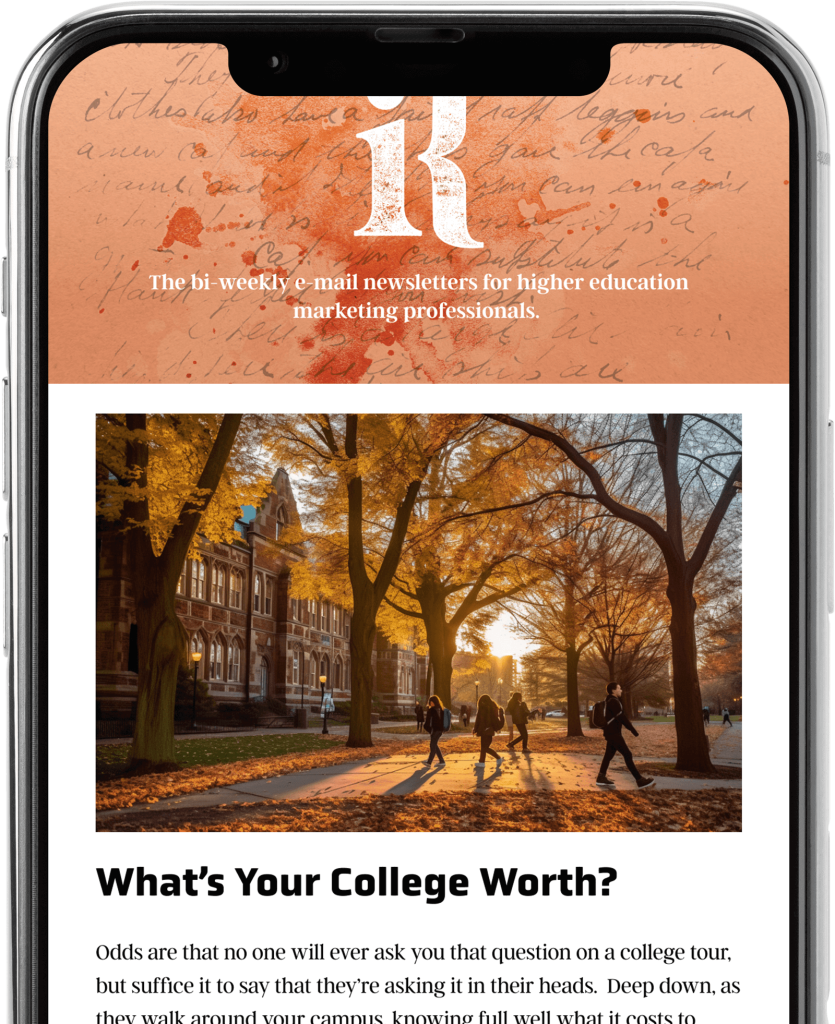HIGHER EDUCATION BRAND
Does Your Collegiate Brand Have a Vision?

Admittedly, the concept of a brand is, to use a sophisticated term, squishy. As we’ve said, a brand is not tangible. It’s not something you can put in your pocket or bring to a meeting to show off. It’s hard (well, impossible) to get your arms around.
This becomes even more difficult when you try to explain your brand to others, let alone define it for yourself. If a new employee started working at your college today, how might you describe it? If your institution hired a new president and needed your help understanding the brand, how might you explain it?
There are several models and frameworks available today but one worth elevating is Professor David Aaker’s Brand Vision Model (formerly known as the Brand Identity Model). This model serves as a template for thinking through, codifying, and promoting the particulars of your institutional brand for just these very situations. In the words of Aaker himself, it’s “an articulated description of the aspirational image for the brand; what you want the brand to stand for in the eyes of customers and other relevant groups like employees and partners.” In short, the Brand Vision Model serves to make your intangible brand, well, tangible.
We might think of this model as a worksheet to begin defining your brand to others. One of the unique facets of this model is that it doesn’t require you to fill in every blank because each brand is unique and certainly varies in terms of where they are in their lifecycle. Other models may demand a marketer to define every facet of a brand which, while challenging is it may be, may yield answers that feel forced. A newer brand that have yet to mature, as an example, may still be seeking to find its way with respect to some brand attributes. Other brands that may be mature might not yet have nor need a way to distinguish themselves in certain facets.
Yet while the model does not require leadership to complete every field within a form, Aaker does encourage us to think beyond just a few words: “a brand is more than a three-word phrase; it may be based on six to twelve vision elements.” This notion is worth contemplating and is particularly important in higher education marketing. Simply reducing an institutional brand to a handful of words typically results in a brand that sounds a great deal like its peers or competitors. This exacerbates the already existing problem that too many colleges are using the same words to talk about themselves.
Your brand’s vision should also be aspirational. What you end up from the perspective of a codified brand should feel just out of reach—just beyond where you are now yet not reaching too far. Being too aspirational might erode the credibility of the brand or the process itself.
The end result of this exercise is a document or slide deck that is intended for internal audiences and members of the brand team. It’s not something that an institution would necessarily publish on the ‘About Us’ section of its website. It’s more for brand builders, writers, designers, and leaders to embody the same aspirational spirit. The finished document might also be used to tell the brand story to a new hire during orientation; certainly you want your entire team to be singing from the same sheet of brand music.
Working with the Brand Vision Model
There are some variations of the Brand Vision model in circulation. A quick search of Google Images reveals some different approaches to the framework itself. In essence, though, the model is comprised of 3 concentric circles to frame the varying components of a brand.

Extended Identity: This involves the specific attributes and associations that differentiate the brand in the minds of stakeholders. For a university, this might include its location, campus facilities, faculty expertise, student organizations, alumni network, and extracurricular opportunities. You might use this area to personify the brand with a well-known person, a symbol, an analogy of some sort, or a characterization of the organization. A brand like Anheuser-Busch uses the famed Clydesdale horse to represent strength, Americana, and beauty. Higher education marketers must identify and promote these unique features to attract students and faculty. Some key aspects of this area are:
- Brand as Product
- Product scope
- Product attributes
- Quality/value
- Uses
- Users
- Country of origin
- Brand as Organization
- Organizational attributes
- Local, national, global, etc.
- Brand as Person
- Personality
- Brand-customer relationships
- Brand as Symbol
- Visual imagery and metaphors
- Brand heritage
Core Identity: This presents some of the distinctive core attributes or associations of the brand but stops short of trying to place a singular fine point on the brand. The Oprah Winfrey brand uses attributes like women’s empowerment, spiritual exploration, humility, and resilience to frame the core identity of the brand. For a university, it could be its mission, values, and educational philosophy that drive the inspiration. Higher education marketers need to clearly define what their institution stands for and what sets it apart from others. This might include factors like academic excellence, a commitment to diversity and inclusion, research opportunities, or a particular educational approach. One helpful way to approach it is to think about the 4-5 most palpable or prominent brand associations and arrange them as independent yet synergistic concepts.
Brand Essence: This encapsulates the timeless and aspirational qualities of the brand. The essence of a brand like Disney might be “family magic” while that of Apple might be “unleashing your inner artist.” Note how distant those statements are from the actual product or service delivered. In higher education, it might be the overarching purpose or impact the institution aims to achieve. This could include goals like preparing students for success in their careers, advancing knowledge through research, fostering innovation, or serving the community. It should evoke a feeling, though, and fairly be regarded as visceral or emotive. While a brand essence isn’t necessarily required, it can be quite powerful once established.
It takes some work and practice to get comfortable with the brand vision model. At times it can feel like a struggle to both understand the concepts and understand which ones relate to your brand and in what way. That struggle if often the precursor to a well-defined brand.
Like what you're reading?
Subscribe to our newsletter to get the latest insights in Higher Education and thought leadership.


